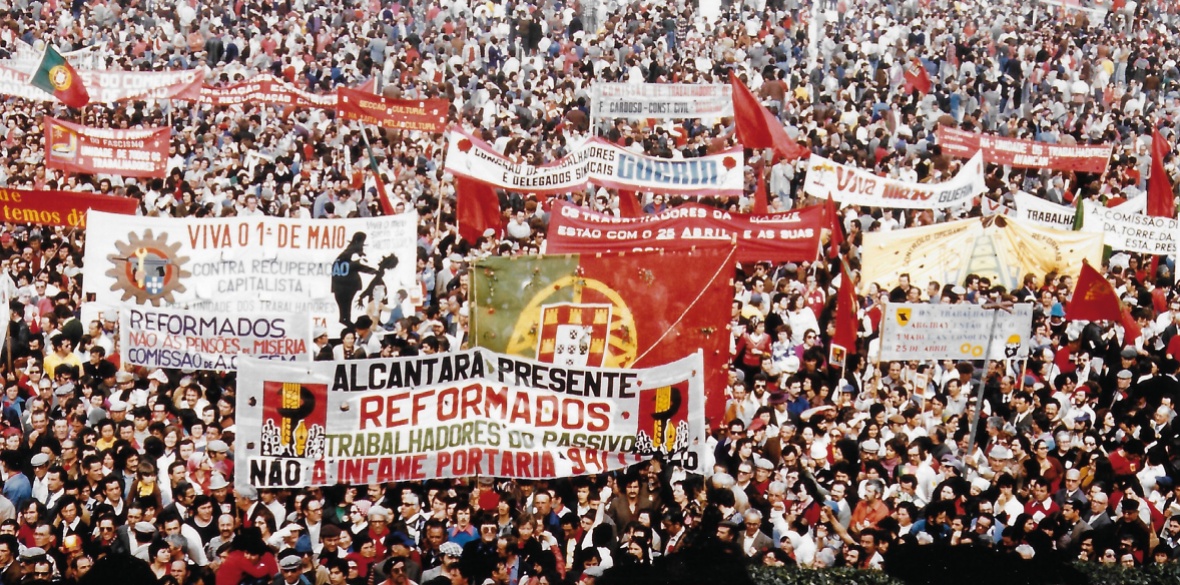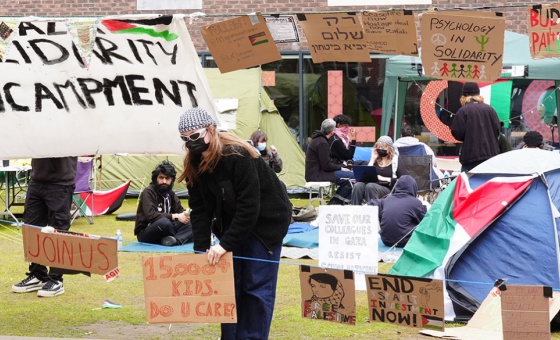This is the last article you can read this month
You can read more article this month
You can read more articles this month
Sorry your limit is up for this month
Reset on:
Please help support the Morning Star by subscribing here
ON APRIL 25, 50 years ago, Portugal was hit by an earthquake. It wasn’t like the geological one of 1755 which razed the capital Lisbon to the ground and killed around 50,000 people; this one was a political earthquake and there were only four victims, shot by the fascist secret police.
It sent shock waves around the world: Portugal’s 41-year-old dictatorship, the oldest in Europe, had been overthrown in just 24 hours. Working for GDR television at the time, I was sent to cover events as they unfolded.
We touched down at Lisbon airport on the morning of the 27th, immediately unpacked our camera and started filming. We hardly put the camera down from then on. Already at the airport, the atmosphere was charged: large groups of people waited for their loved ones to arrive, exiled for years by the dictatorship. There were ecstatic embraces, laughter and tears of joy.
The centre of Lisbon was awash with flowers and knots of jubilant groups on every street corner. Soldiers and sailors stood sentry in front of official buildings, not in a menacing manner, but nonchalant and relaxed, red carnations in their lapels or the barrels of their guns, now converted from killing tools into flower vases.
They were continually embraced by the ordinary people, who showered them with flowers and kisses, drinks and food. I have never seen an army so at one with the people. One young conscript told us: “Yes, we now have a unity between the people and the armed forces, and we must make sure no-one destroys that.”
Every street corner, office and factory became a beehive of revolutionary activity. Political prisoners, some who had been languishing in the dictator Caetano’s notorious jails in Caxias and Peniche for years, were released into the arms of their overjoyed families; the secret police headquarters, the radio stations and government buildings were now in the hands of rebel soldiers; trade unions were re-established; housing associations and local residents’ committees set up; and political parties mushroomed from nowhere. I instinctively felt the parallels with the Bolshevik Revolution of 1917, as described by John Reed in Ten Days that Shook the World.
Here were similar-looking, conscripted, young working-class or peasant soldiers and sailors, who’d taken power. There was a ferment and highly charged emotional debates in smoke-filled rooms, the rushing back and forth with messages and instructions, pickets outside important buildings — apparent chaos, but in fact, a new order self-imposed by the citizens themselves, imbued with that indescribable feeling of emerging from a deep, dark pit into the brimming light of freedom. There was a palpable sense of unity and fraternity, of national dignity, with everyone celebrating together.
Of course, such a euphoric atmosphere is to be expected when an oppressive regime is overthrown — everyone feels united in their new-found freedoms and joy in victory. It is only later, when the real debate over the way forward begins, over possible solutions, that differences emerge, but in these early days such forebodings were far from everyone’s minds.
One of the first places we filmed was the former headquarters of PIDE, the secret police. The naval guards at the main gate took us to the officer in command, who let us film what we wanted. There is no bureaucracy, no wish to hide things. The whole building was still in the state it was on that momentous day of April 25. Papers were strewn over the floor, drawers left open as they were when everyone left in such haste.
Silva Pais, the security chief, had also departed in a great hurry. In his wood-panelled office, with its heavy oak desk, his diary was still open on the 25th, papers held down by an enormous plaster penis, and a half-drunk bottle of Johnny Walker stood next to two dirty glasses.
On the bookshelf behind the desk was a selection of books, including, perhaps surprisingly, Regis Debray on Che Guevara, tomes on the history of the USSR, communism in Africa, a Batista autobiography, several books on Cuba and Nazism, one on karate and a gun catalogue.
Our officer-guide shows us a recess let into his desk in which a hidden microphone and a cassette recorder are concealed. He then takes us to the offices where the files were kept on opponents of the regime — the many left-wing, progressive or simply suspect individuals.
We discover the file on Alvaro Cunhal, the general secretary of the Portuguese Communist Party. There are piles of fake student identity cards, several passports, mainly French, police photos and a children’s printing outfit, probably used to forge leaflets to incriminate innocent victims.
In the basement are the cellars where those arrested were tortured. One room contains a collection of porno films, where the secret police found titillation and blunted what residual sensitivities they may have had before embarking on their bloody tasks.
We go to gatherings and meetings in so many places that our heads are spinning. In Barreiro, the “red suburb” of Lisbon, we witness the opening of the first legal Communist Party offices and the first meeting of local comrades, who still can’t quite get used to the idea that they now have nothing to fear.
One older comrade who works in the local CUF steel factory (the Companhia Uniao Fabril is one of the largest and most diversified of the Portuguese conglomerates) insists on dragging us to his small works flat.
Inside, in the spartanly furnished room, he takes down a dusty book from a high shelf and proudly shows it to us — a copy of Marx’s Capital! He explains how he’s kept it hidden for almost 40 years but can now bring it out and read it openly.
In this same factory a few months later there are communist posters everywhere and a group of workers proudly drive a fork-lift truck onto the factory floor for us to film: it has been covered in revolutionary slogans and has been named VI Lenin! Cries of “PCP, PCP” resound from around the works and clenched fists are raised in the air. In the huge ship repair yard of Lisnave, it is a similar story. There is an infectious euphoria.
A group of young officers who were closely involved in the revolution from the start — and it was primarily middle-ranking younger officers who carried it out — invite us to their barracks to talk to some of those who took part in the coup. It was the Escola Pratica de Cavalaria, the cavalry school in Santarem, which led one of the first columns to enter Lisbon.
The final signal for the revolution to begin was a song broadcast on the radio by popular, left-wing Portuguese singer Jose Alfonso. His song, Grandola Vila Morena, conjured up images of Portugal and its people.
When this song rang out at midnight over the airwaves the officers at the school started up the engines of their old, armoured cars and jeeps and headed for the centre of Lisbon, 20km or so away. This action almost misfired because one of the vehicles leading the column was so ancient it broke down en route, but they managed to repair it. They told us how nervous they were and uncertain whether the coup would come off.
The second and concluding part will run in tomorrow’s edition.










